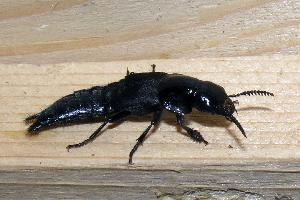
Poids et mesures
| Longueur | de 15 à 24 mm |
|---|
Description de l'animal
The Hornet rove beetle, scientifically named Velleius dilatatus, is a fascinating and somewhat intimidating species of beetle belonging to the Staphylinidae family, widely known for their diverse shapes and ecological roles. This particular species has garnered attention due to its unique appearance and behavior that mimic those of a hornet, a clever evolutionary strategy known as Batesian mimicry which serves to deter predators by imitating the warning signals of a more dangerous species.Velleius dilatatus is predominantly found across Europe, with sightings reported from various habitats ranging from woodlands to gardens, indicating a preference for environments where it can freely hunt and scavenge. This beetle is relatively large for a rove beetle, reaching lengths of up to 15-20 mm. Its body is elongated and somewhat flattened, a common characteristic among rove beetles, allowing it to maneuver easily through soil and under debris.
The most striking feature of the Hornet rove beetle is undoubtedly its coloration and patterning, which closely resembles that of a hornet. Its body is black with yellow to orange markings, and its abdomen is segmented and elongated, mimicking the appearance of a hornet's warning coloration. This mimicry extends to its behavior as well; when threatened, Velleius dilatatus will raise its abdomen and move it from side to side, similar to the warning signals of a hornet, thus deterring potential predators through deception.
Despite its fierce appearance, the Hornet rove beetle is primarily a scavenger and predator of small invertebrates. It plays a significant role in the ecosystem by helping to control pest populations and decompose organic matter. The beetle is nocturnal, preferring to hunt and scavenge under the cover of darkness. During the day, it hides under rocks, logs, or leaf litter, emerging at night to feed.
The lifecycle of Velleius dilatatus begins with the female laying eggs in moist soil or under debris. The larvae, which are carnivorous like the adults, go through several developmental stages before pupating and emerging as fully grown beetles. This process can vary in length depending on environmental conditions such as temperature and availability of food.
In terms of human interaction, the Hornet rove beetle is generally considered harmless. It does not sting or bite, and while its appearance may be alarming to some, it poses no threat to humans or pets. In fact, its presence is beneficial as it helps control the populations of other, more problematic insects.
Overall, the Hornet rove beetle, Velleius dilatatus, is a remarkable example of nature's ingenuity, utilizing mimicry as a defense mechanism while contributing positively to its ecosystem. Its unique appearance and behaviors continue to intrigue and fascinate entomologists and nature enthusiasts alike.
Nouvelles photos d'animaux
Top 10 des animaux
- Dolphin gull (Leucophaeus scoresbii)
- Diana monkey (Cercopithecus diana)
- Moustached guenon (Cercopithecus cephus)
- Galápagos tortoise (Geochelone nigra complex)
- Russian tortoise (Testudo horsfieldii)
- Japanese macaque (Macaca fuscata)
- Stone loach (Barbatula barbatula)
- Greek tortoise (Testudo graeca)
- Common flying dragon (Draco volans)
- Colossal squid (Mesonychoteuthis hamiltoni)